Chapter 18.18
SIGNS
Sections:
18.18.070 Signage allowances by zoning district.
18.18.080 Signage allowances for specific uses and development.
18.18.090 Signage standards for specific sign types.
18.18.100 Freeway-oriented signs.
18.18.120 Modification to sign standards.
18.18.140 Comprehensive sign program.
18.18.150 Nonconforming signs.
18.18.010 Purpose.
The purpose of this chapter is to promote the public health, safety, and welfare through a comprehensive system of reasonable, effective, consistent, content-neutral, and nondiscriminatory sign standards and requirements. More specifically, this chapter is intended to:
A. Balance public and private objectives by allowing adequate avenues for both commercial and noncommercial messages;
B. Allow signs to serve as an effective channel of communication while preventing visual clutter that will detract from the aesthetic character of the City;
C. Maintain and enhance the City’s appearance by regulating the location, number, type, quality of materials, size, illumination, and maintenance of signs;
D. Restrict signs that may create a nuisance to nearby properties, violate privacy, or create hazards or unreasonable distractions for pedestrians or drivers;
E. Provide clear and unambiguous sign standards that enable fair and consistent enforcement; and
F. Ensure that the constitutionally guaranteed right of free speech is protected. [Ord. 24-002 § 5 (Exh. A).]
18.18.020 Applicability.
The provisions of this chapter apply to all signs in all districts, constructed or physically altered on or after the effective date of this code, unless otherwise specified. The provisions of this chapter apply in addition to any other section of the municipal code, including Chapter 6.12 DMC, Cannabis Business Pilot Program.
A. Message Neutrality. It is the City’s policy and intent to regulate signs in a manner consistent with the U.S. and California Constitutions, which is content neutral as to noncommercial speech and does not favor commercial speech over noncommercial speech.
B. Public Forum. The provisions of this chapter shall not be construed to prohibit a person from holding a sign while picketing or protesting on public property that has been determined to be a traditional or designated public forum, so long as the person holding the sign does not block ingress and egress from buildings; create a safety hazard by impeding travel on sidewalks, bike lanes, or vehicle lanes; or violate any other reasonable time, place, and manner restrictions adopted by the City.
C. Registered Mark. The provisions of this chapter shall not require alteration of the display of any registered mark, trademark, service mark, trade name, or corporate name that may be associated with or incorporated into a registered mark, where such alteration would require the registered mark to be displayed in a manner differing from the mark as exhibited in the certificate of registration issued by the United States Patent and Trademark Office. It is the responsibility of the applicant to establish that a proposed sign includes a registered mark.
D. Regulatory Interpretations. All interpretations of this chapter are to be exercised in light of the message neutrality and message substitution policies.
E. Noncommercial Signs. Noncommercial signs are allowed wherever commercial signage is permitted and are subject to the same standards and total maximum allowances per site or building of each sign type specified in this chapter. [Ord. 24-002 § 5 (Exh. A).]
18.18.030 Exemptions.
The following signs are exempt from the permit requirements of this chapter, and do not count toward the maximum sign area limitation for a site; provided, that they conform to the specified standards:
A. Address Signs. Required address identification signs that are in conformance with the building code.
B. Commercial Displays on Vehicles. Displays on vehicles related to the goods or services provided by the vehicle owner or operator and public transit/public carrier graphics on properly licensed buses, taxicabs, and similar vehicles for hire that legally pass through the City.
C. Directional/Informational Signs. Directional and/or informational signs not more than eight (8) square feet in area or four (4) feet in height for the direction or convenience of the public such as outlining/assisting vehicle and pedestrian circulation within a site, egress, ingress, and any public facilities such as restrooms, telephones, walkways, and other similar features.
D. Flags. Flags that do not display a commercial message.
E. Government Signs. Official notices issued by a court, public body, or office and posted in the performance of a public duty; notices posted by a utility or other quasi-public agency; signs erected by a governmental body to direct or regulate pedestrian or vehicular traffic; noncommercial bus stop signs erected by a public transit agency; or other signs required or authorized by law.
F. Historic Plaques and Commemorative Signs. Historic plaques, memorial signs or tablets, or commemorative signs indicating names of buildings and dates of building erection, either attached to or cut into the surfaces of buildings, with a maximum allowable sign area of four (4) square feet per sign.
G. Interior Signs. Signs that are in the interior areas of a building or site not visible from the public right-of-way, and at least five (5) feet from a window, door, or other exterior wall opening.
H. Manufacturer’s Mark. Manufacturer’s marks, including signs on items such as vending machines, gas pumps, and ice containers with a maximum allowable sign area of four (4) square feet per sign.
I. Nameplate. One (1) nameplate for each tenant or occupancy not to exceed two (2) square feet in area indicating the name of the occupant or tenant. [Ord. 24-002 § 5 (Exh. A).]
18.18.040 Prohibitions.
Unless otherwise permitted by a specific provision of this chapter, the following sign types are prohibited:
A. Animated or Moving Signs. Animated, flashing, blinking, reflecting, revolving, or other similar sign with visibly moving or rotating elements or visible mechanical movement of any kind, unless expressly permitted by another section of this chapter.
B. Balloons, Inflatable Signs, Streamers, Pennants and Other Attention-Getting Devices. Balloons, inflatable signs, streamers, pennants, and other attention-getting devices, made of lightweight fabric or similar material, designed to rotate or move with the wind, that direct, promote, or that are otherwise designed to attract attention.
C. Mobile Billboards. Any sign carried or conveyed by a vehicle for the primary purpose of general advertising for hire. This prohibition eliminates mobile billboard advertising within the City to reduce traffic congestion, promote the safe movement of vehicular traffic, reduce air pollution, and improve the aesthetic appearance of the City. This prohibition does not apply to displays on vehicles related to the goods or services provided by the vehicle owner or operator, public safety and public transit/public carrier graphics on properly licensed buses, taxicabs, and similar vehicles for hire that legally pass through the City.
D. Off-Site Signs. Any sign advertising any activity, business, product, or service that is not conducted on the premises upon which the sign is located, unless expressly permitted by another section of this chapter.
E. Roof Signs.
1. Attached signs that extend above the roofline or parapet (whichever is higher) of a building with a flat roof.
2. Attached signs that extend above the deck line of a mansard or false-mansard roof.
3. Signs on rooftop structures, such as penthouse walls or mechanical enclosures.
F. Searchlights and Klieg Lights. Search and Klieg lights when used as attention-attracting devices for commercial uses.
G. Signs Located in the Public Right-of-Way or on Public Property. Other than official government signs or warning signs required by law, no inanimate sign can be placed in or project into the public right-of-way or on public property unless authorized by an encroachment permit.
H. Signs Affixed to Trees. Signs affixed to or cut into trees or other living vegetation shall be prohibited.
I. Signs on Terrain. Signs cut, burned, marked, or displayed in any manner on a street, sidewalk, cliff, hillside, or other terrain feature shall be prohibited.
J. Signs Creating Traffic or Pedestrian Safety Hazards. Signs placed, located, or displayed in such a manner as to constitute a traffic or pedestrian safety hazard shall be prohibited.
1. Signs that obstruct use of any door, window, or fire escape.
2. Signs that impede normal pedestrian use of public sidewalks. A minimum unobstructed width of four (4) feet must always be maintained.
3. Signs that constitute a traffic hazard or obstruct the view of traffic, any authorized traffic sign, or signal device.
4. Signs that create confusion or conflict with any authorized traffic sign or signal device due to color, location, wording, or use of specific phrases, symbols, or characters.
K. Signs Producing Noise or Emissions. Signs producing visible smoke, vapor, particles, odor, noise, or sounds that can be heard at the property line shall be prohibited. This prohibition excludes menu boards with voice units at drive-through facilities.
L. Signs for Prohibited Uses. A sign displaying a commercial message promoting a business that is a prohibited use and has not been established as a legal nonconforming use.
M. Unauthorized Signs. Signs shall not be placed on private or public property without the permission of the property owner. [Ord. 24-002 § 5 (Exh. A).]
18.18.050 Sign measurement.
A. Measuring Sign Area. The area of a sign face includes the entire area within a single continuous perimeter composed of squares and rectangles that enclose the extreme limits of all sign elements, including, without limitation, sign structures or borders, written copy, logos, symbols, illustrations, and color. Supporting structures, such as sign bases and columns, are not included in sign area; provided, that they contain no lettering or graphics except for addresses. The area of an individual sign shall be calculated as follows: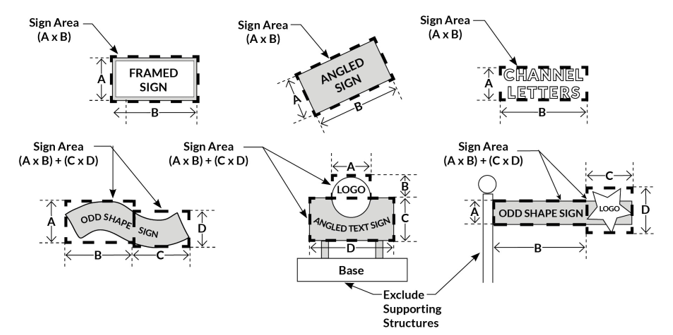
FIGURE 18.18.050.A: MEASURING SIGN AREA
1. Single-Faced Signs. The sign area of a sign with a single face area is the area of the sign face.
2. Double-Faced Signs. Where two (2) faces of a double-faced sign are located two (2) feet or less from one another at all points, or located at an interior angle of forty-five (45) degrees or less from one another, the sign area of double-faced signs is computed as the area of one (1) face. Where the two (2) faces are not equal in size, the larger sign face will be used. Where two (2) faces of a double-faced sign are located more than two (2) feet or greater than forty-five (45) degrees from one another, both sign faces are counted toward sign area.
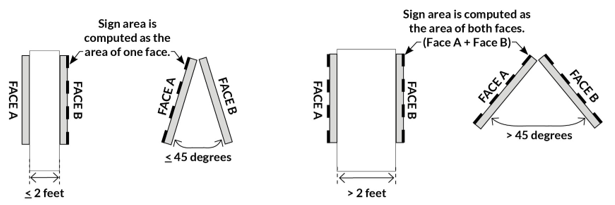
FIGURE 18.18.050.A.2: MEASURING SIGN AREA, DOUBLE-FACED SIGNS
3. Multi-Faced Signs. On a three (3) faced sign, where at least one (1) interior angle is forty-five (45) degrees or less, the area of two (2) faces (the largest and smallest face) must be summed to determine sign area. In all other situations involving a sign with three (3) or more sides, sign area will be calculated as the sum of all faces.

FIGURE 18.18.050.A.3: MEASURING SIGN AREA, MULTI-FACED SIGNS
4. Three (3) Dimensional Signs. Signs that consist of, or have attached to them, one (1) or more three (3) dimensional objects (i.e., balls, cubes, clusters of objects, sculpture, or statue-like trademarks), may have a sign area that is the sum of all areas using the four (4) vertical sides of the smallest rectangular prism that will encompass the sign.
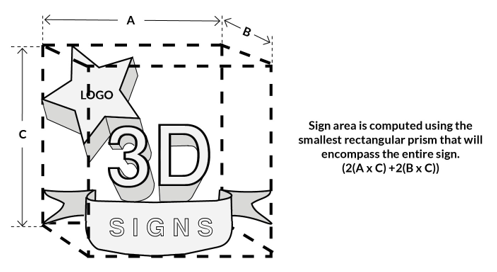
FIGURE 18.18.050.A.4: MEASURING SIGN AREA, 3D SIGNS
B. Measuring Sign Height. The height of a sign is the vertical distance from the uppermost point used to measure sign area to the existing grade immediately below the sign.

FIGURE 18.18.050.B: MEASURING SIGN HEIGHT
C. Measuring Sign Clearance. Sign clearance shall be measured as the smallest vertical distance between finished grade and the lowest point of the sign, including any framework or background embellishments.
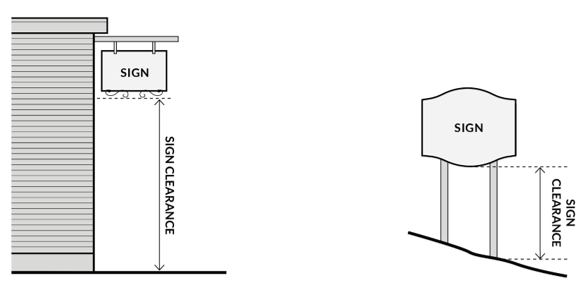
FIGURE 18.18.050.C: MEASURING SIGN CLEARANCE
[Ord. 24-002 § 5 (Exh. A).]
18.18.060 General provisions.
This section establishes general standards that apply to all sign types and in all districts.
A. Applicable Codes. In addition to complying with the provisions of this section, all signs must be constructed in accordance with applicable construction, sign, and building codes and all other applicable laws, rules, regulations, and policies.
B. Sign Clearance. Signs shall have a minimum of eight (8) feet clearance when located above any walkway or area where people may walk and fourteen (14) feet above any parking area or drive aisle.
C. Illumination. An illuminated sign within three hundred (300) feet of a residential district within the City limits, measured along the radius of a one hundred eighty (180) degree arc in front of a face of a sign, shall not be directly lighted but may be indirectly lighted or may have semi-indirect or diffused lighting. The lighting fixture shall be shielded such that the lamp (light bulb) is not visible.
D. Projections Into the Public Right-of-Way. In the DMX district, signs mounted on private property may project into or above public property or the public right-of-way up to within two (2) feet of the curb line of a street or alley with approval of an encroachment permit by the Public Works Director. Such signs shall also meet the sign clearance requirements of subsection B of this section, Sign Clearance.
E. Materials. Signs shall be made of sturdy, durable materials. Paper, cardboard and other materials subject to rapid deterioration shall be limited to temporary signs. Fabric signs are limited to awnings, canopies, flags, and temporary signs. [Ord. 24-002 § 5 (Exh. A).]
18.18.070 Signage allowances by zoning district.
This section establishes the types of signs allowed per zoning district. These signs are also subject the regulations in DMC 18.18.060, General provisions, and all standards specific to the specific sign type.
A. Types of Signs Allowed. Table 18.18.070.A: Allowed Signs by Zoning District, establishes the types of signs allowed per zoning district.
|
✔ Allowed (subject to compliance with this chapter) |
– Not Allowed |
||||||
|---|---|---|---|---|---|---|---|
|
Zoning Districts |
Sign Type |
||||||
|
Wall Signs |
Freestanding Signs |
Awning and Canopy Signs |
Projecting and Shingle Signs |
Window Signs |
Freeway-Oriented Signs |
Temporary Signs |
|
|
Residential Districts |
|||||||
|
See DMC 18.18.080, Signage allowances for specific uses and development and DMC 18.18.110, Temporary signs |
|||||||
|
Commercial and Mixed-Use Districts |
|||||||
|
All Commercial and Mixed Districts |
See DMC 18.18.080, Signage allowances for specific uses and development, and DMC 18.18.110, Temporary signs |
||||||
|
CAMX |
✔ |
✔ |
✔ |
✔ |
✔ |
– |
✔ |
|
CMX |
✔ |
✔ |
✔ |
✔ |
✔ |
– |
✔ |
|
DMX |
✔ |
✔ |
✔ |
✔ |
✔ |
– |
✔ |
|
CN |
✔ |
✔ |
✔ |
✔ |
✔ |
– |
✔ |
|
CR |
✔ |
✔ |
✔ |
✔ |
✔ |
✔ |
✔ |
|
CS |
✔ |
✔ |
✔ |
✔ |
✔ |
– |
✔ |
|
Industrial Districts |
|||||||
|
All Industrial Districts |
See DMC 18.18.080, Signage allowances for specific uses and development, and DMC 18.18.110, Temporary signs |
||||||
|
IL |
✔ |
✔ |
✔ |
✔ |
✔ |
– |
✔ |
|
IG |
✔ |
✔ |
✔ |
✔ |
✔ |
– |
✔ |
|
Public and Semi-Public Districts |
|||||||
|
All Public and Semi-Public Districts |
See DMC 18.18.080, Signage allowances for specific uses and development, and DMC 18.18.110, Temporary signs |
||||||
|
PF |
✔ |
✔ |
✔ |
✔ |
✔ |
✔ |
✔ |
|
PR |
✔ |
✔ |
✔ |
✔ |
✔ |
✔ |
✔ |
B. Allowed Sign Area. Table 18.18.070.B establishes the maximum aggregate sign area allowed per site.
1. Calculation of Aggregate Sign Area. The sign area of all signs on site is included in the calculation of aggregate sign area, except for the signs listed below, which are excluded from the calculation.
a. Sign Area Excluded From the Calculation of Aggregate Sign Area. The sign area of the following signs is excluded from the calculation of aggregate sign area:
(i) Signs that are exempt from the permit requirements of this chapter pursuant to DMC 18.18.030, Exemptions.
(ii) Signs allowed pursuant to DMC 18.18.080, Signage allowances for specific uses and development.
(iii) Additional freestanding signs in the CR district allowed pursuant to DMC 18.18.090(B)(3), Additional Freestanding Sign Allowance, CR District.
(iv) Freeway-oriented signs consistent with DMC 18.18.100, Freeway-oriented signs.
(v) Temporary signs consistent with DMC 18.18.110, Temporary signs.
|
Zoning District |
Maximum Allowable Aggregate Sign Area |
|---|---|
|
Residential Districts |
Allowable sign area is determined by the specific sign allowances in DMC 18.18.080, Signage allowances for specific uses and development |
|
CMX, DMX, and CN Districts |
1 square foot per linear foot of building frontage or width of tenant space or 20 square feet per tenant space, whichever is greater |
|
CAMX, CR and CS Districts |
2 square feet per linear foot of building frontage or width of tenant space or 30 square feet per tenant space, whichever is greater |
|
IL and IG Districts |
1 square foot per linear foot of building frontage or width of tenant space or 20 square feet per tenant space, whichever is greater. |
[Ord. 24-002 § 5 (Exh. A).]
18.18.080 Signage allowances for specific uses and development.
This section establishes signage allowances for specific uses and development. These signs are allowed in addition to the signs allowed by zoning district in DMC 18.18.070, Signage allowances by zoning district, and are not included in the calculation of aggregate sign area. These signs are also subject to the regulations in “Standards for Specific Sign Types” unless otherwise stated.
A. Residential Developments. Residential developments of four (4) or more units or lots are allowed freestanding and wall signs up to a total aggregate sign area of one (1) square foot per dwelling unit, subject to the following standards:
1. Maximum Number of Signs. Two (2) per entrance to the development.
2. Maximum Size per Sign. Forty (40) square feet.
3. Illumination. Sign lighting is limited to external illumination. Internally illuminated signs and bare bulbs are prohibited.
B. Nonresidential Uses in Residential Districts. Nonresidential uses that are the primary use on a site in a residential district are allowed up to a total aggregate sign area of one (1) square foot per linear foot of building frontage. Allowed sign types, maximum sign area for individual signs, and allowed illumination is as follows:
1. Awning and Canopy Signs. Maximum size of six (6) square feet or twenty-five percent (25%) of the surface area of the awning, whichever is less.
2. Window Signs. Maximum size of fifteen percent (15%) of window area.
3. Wall Signs. Maximum size of twenty (20) square feet.
4. Freestanding Signs. Maximum size of thirty (30) square feet.
5. Illumination. Sign lighting is limited to external illumination. Internally illuminated signs and bare bulbs are prohibited. [Ord. 24-002 § 5 (Exh. A).]
18.18.090 Signage standards for specific sign types.
This section establishes standards for specific sign types that apply to all districts where such signs are allowed.
A. Awning and Canopy Signs. Signs painted or printed on awnings, canopies, arcades, or similar attachments or structures are subject to the following standards:
1. Maximum Allowable Sign Area. Awning and canopy signs shall have a maximum allowable sign area of ten (10) square feet, or twenty-five percent (25%) of the total awning area, whichever is less.
2. Maximum Sign Height. Awning and canopy signs shall have a maximum height of fourteen (14) feet.

FIGURE 18.18.090.A: AWNING AND CANOPY SIGNS
B. Freestanding Signs. Freestanding signs are subject to the following standards:
1. Maximum Sign Height. Eight (8) feet.
2. Maximum Number of Signs. One (1) freestanding sign plus one (1) for every seventy-five (75) feet of street frontage over seventy-five (75).
3. Additional Freestanding Sign Allowance, CR District. In addition to the other sign allowances pursuant to this chapter, an additional freestanding sign may be allowed in the CR district, subject to the following standards:
a. Required Permit. Conditional use permit approval pursuant to Chapter 18.24 DMC, Use Permits, is required.
b. Maximum Sign Height. The maximum sign height shall be established through the conditional use permit approval in consideration of a sight line study for view and visibility distance which shall be prepared and submitted with an application to justify the height of the sign requested. However, the maximum height of the sign shall not exceed eighty-five (85) feet.
c. Maximum Number of Signs. A maximum of one (1) additional freestanding sign may be allowed.
d. Location. Multi-tenant freeway-oriented sign structures shall be no closer together than two thousand (2,000) feet from one to another, measured parallel to the freeway.
e. Subject Location. Businesses, products, services, or entities advertising on sign structures must be located on the same site as the sign and located within one-half (0.5) mile of the centerline of Interstate 80; except as allowed for electronic message center signs pursuant to subsection (B)(3)(j) of this section, Electronic Message Center.
f. Sign Structure. The design of the sign structure, including base, shall incorporate architectural design features to enhance appearance.
g. Size of Signage. Signage, including text or graphics, must be of sufficient size to be easily readable for freeway drivers. In the event an applicant for signage disputes requirements of “sufficient size” for readability established by the Planning Commission or administrative design approval, Caltrans freeway signage readability standards shall be utilized.
h. Center Identification. The topmost position on the sign shall reflect the name of the commercial area or center for which the sign is primarily intended, or a major tenant as determined by the Planning Commission during the sign review process.
i. Signage Lease Spaces.
(i) The size and number of signage lease spaces shall be established at the time of sign design review for the sign structure. Subdivision of signage lease space areas, other than as established at the time of sign design review, shall not be permitted.
(ii) There shall be a minimum of three (3) signage lease spaces provided on the additional freestanding sign.
j. Electronic Message Center. Electronic message center signs may be permitted subject to the following:
(i) Electronic message signs located within five hundred (500) feet of a residential district shall not be utilized from 11:00 p.m. to 6:00 a.m.
(ii) The sign area of an electronic message center sign shall not exceed six hundred seventy-five (675) square feet.
(iii) The static messages shall not change more frequently than every six (6) seconds, and cannot pulse or significantly change in luminosity.
k. Timing of Permits. No permit shall be issued for construction of a sign structure prior to the initiation of construction of at least one (1) business or entity which will place signage on the structure.
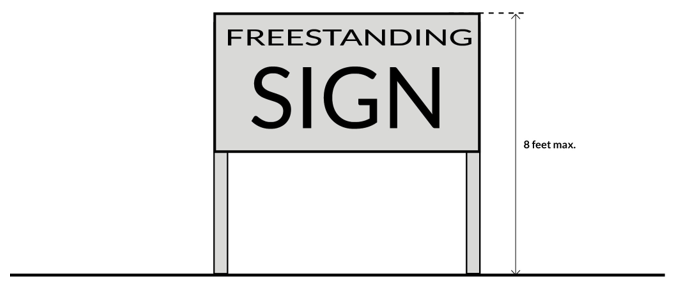
FIGURE 18.18.090.B: FREESTANDING SIGNS
C. Projecting and Shingle Signs. Signs that project horizontally from the exterior wall of a building or are suspended beneath a marquee, covered walkway, canopy, or awning, are subject to the following standards:
1. Maximum Allowable Sign Area. Six (6) square feet.
2. Maximum Sign Height. Fifteen (15) feet.
3. Maximum Number of Signs. One (1) for each building frontage or tenant space.
4. Projection Allowed.
a. Projecting Sign. A projecting sign cannot extend more than four (4) feet from the building to which it is attached.
b. Shingle Sign. A shingle sign cannot extend further than the outer edge of the marquee, covered walkway, canopy, or awning from which it is suspended.
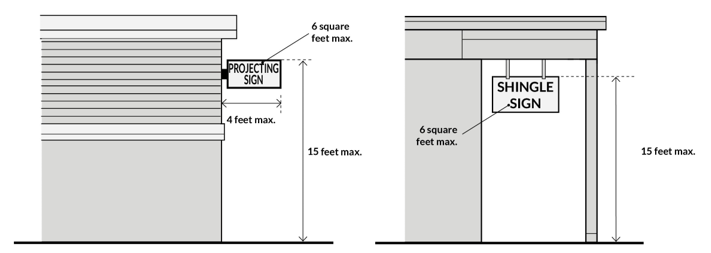
FIGURE 18.18.090.C: PROJECTING AND SHINGLE SIGNS
D. Wall Signs. Wall signs include any sign attached to, erected against or painted upon the wall of a building or structure. Wall signs are subject to the following standards:
1. Maximum Allowable Sign Area. In all cases, wall sign copy shall not occupy more than twenty-five percent (25%) of the total area of the wall to which the sign is attached.
2. Location of Sign.
a. Wall signs shall not be placed higher than the second story of a building.
b. Wall signs shall not cover or interrupt major architectural features, including such features as doors, windows, or tile embellishments.
c. Wall signs shall not extend higher than the building wall upon which they are attached.
3. Maximum Number of Signs. One (1) per building frontage or tenant space.
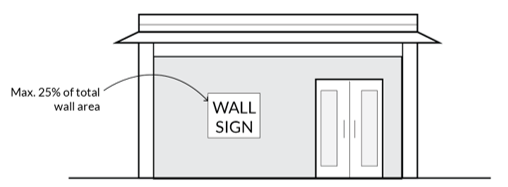
FIGURE 18.18.090.D: WALL SIGNS
E. Window Signs. Signs painted on or otherwise adhered directly onto a window and signs that block a window in any way are subject to the following standards:
1. Maximum Allowable Sign Area. Twenty percent (20%) of the window area.
2. Maximum Sign Height. Window signs shall not be placed on windows higher than the second story.

FIGURE 18.18.090.E: WINDOW SIGNS
[Ord. 24-002 § 5 (Exh. A).]
18.18.100 Freeway-oriented signs.
In addition to the other sign allowances pursuant to this chapter, freeway-oriented sign structures may be allowed in the CR district subject to conditional use permit approval and the following criteria:
A. Freeway-oriented sign structures may only be located in a CR district located along Interstate 80.
B. A sight line study for view and visibility distance shall be prepared and submitted with an application to justify the height of the sign requested. However, the maximum height of the sign shall not exceed eighty-five (85) feet.
C. Design of the sign structure shall incorporate architectural design features to enhance appearance.
D. Sign structures must be in compliance with all applicable State and Federal regulations, including but not limited to the State Outdoor Advertising Act. Proof of such compliance must be submitted prior to issuance of the permit for construction of the sign structure.
E. Signage, including text or graphics, must be of sufficient size to be easily readable for freeway drivers. In the event an applicant for signage disputes requirements of “sufficient size” for readability established by the Planning Commission or administrative design approval, Caltrans freeway signage readability standards shall be utilized.
F. The size and number of signage lease space shall be established at the time of sign design review for the sign structure. Subdivision of signage lease space area, other than as established at the time of sign design review, shall not be permitted.
G. Electronic Message Center. Freestanding freeway-oriented signs that include electronic message center signs may be permitted subject to the following:
1. Electronic message signs located within five hundred (500) feet of a residential district shall not be utilized from 11:00 p.m. to 6:00 a.m.
2. The sign area of an electronic message center sign shall not exceed six hundred seventy-five (675) square feet.
3. The static messages shall not change more frequently than every six (6) seconds, and cannot pulse or significantly change in luminosity.
H. Replacement, repair, or modification of signage shall be subject to design review pursuant to Chapter 18.23 DMC, Design Review.
I. Number of Freeway-Oriented Signs.
1. No more than one (1) freeway-oriented sign may be built for every ten thousand (10,000) residents. One (1) additional freeway-oriented sign may be built once the City’s population reaches twenty thousand (20,000), as established by the Solano County Clerk’s office. The additional freeway-oriented sign must be located on the opposite side of Interstate 80 from any existing freeway-oriented sign, and shall not be within a one (1) mile radius from any other existing freeway-oriented sign.
2. Another additional freeway-oriented sign may be built once the City’s population reaches thirty thousand (30,000), as established by the Solano County Clerk’s office. This additional freeway-oriented sign shall not be within a one (1) mile radius from any other existing freeway-oriented sign. [Ord. 24-002 § 5 (Exh. A).]
18.18.110 Temporary signs.
Temporary signs intended to be displayed for a limited period of time are allowed subject to the following standards:
A. Real Estate Signs. One (1) sign pertaining to the sale, lease, rental or display of a structure or land, not exceeding six (6) square feet in a residential district or twenty (20) square feet in a nonresidential district.
B. Open House Signs. A maximum of four (4) open house directional portable signs may be placed off the premises offered for sale or lease in accordance with the following:
1. Signs shall not exceed four (4) square feet in area or three (3) feet in height.
2. Signs may be placed off site on private property only after obtaining permission from the property owner.
3. Signs may be permitted in the public right-of-way when abutting property lines and placed in such a manner that does not interrupt the normal flow of vehicle or pedestrian traffic. Signs are prohibited in the center divider and/or traffic islands of public streets. These signs shall not cause a sight distance problem.
4. Signs may be displayed only on weekends, holidays, and broker tour days between 10:00 a.m. and 5:00 p.m., during the period when the property is available for public showing. Signs shall be removed after each day of showing.
5. An encroachment permit may be required from Caltrans and the City of Dixon before placing an open house directional portable sign in the public right-of-way.
C. Subdivision Signs. Temporary subdivision signs in conformance with the following are permitted in residential districts:
1. One (1) sign pertaining to a subdivision, not illuminated, not exceeding twenty-four (24) square feet in area, may be erected or displayed, for each ten (10) acres in the subdivision. In no case shall the total sign area of such signs exceed forty-eight (48) square feet.
2. If a subdivision has an area of less than ten (10) acres, one (1) sign, not illuminated, not exceeding twenty-four (24) square feet in area, may be erected or displayed.
3. The total number of subdivision signs, other than model home signs and directional signs as permitted in subsections (C)(4) and (C)(5) of this section, shall not exceed three (3).
4. One (1) sign not exceeding six (6) square feet in area, not illuminated, advertising a model home may be erected or displayed on the site of each model home in a subdivision.
5. Not more than four (4) off-site directional signs subject to the following restrictions:
a. Not illuminated.
b. Not more than sixty-four (64) square feet in area, may be erected or displayed for each subdivision.
c. At least two (2) of the four (4) off-site signs shall be constructed to have three (3) additional panels that will be available to advertise other subdivisions.
d. Signs must be located on private property and must have the owner’s consent.
e. Signs shall be located not to cause a safety hazard.
f. Location and design of signs must first be approved by the Community Development Director.
6. A sign permit shall be required for all temporary subdivision signs. A permit may be issued by the Community Development Director at any time after recordation of the subdivision and shall become void one (1) year following the date on which the permit was issued, unless prior to the expiration of that one (1) year a building permit is issued and construction commenced on the homes. A sign permit may be renewed for one (1) additional year if, prior to the expiration of one (1) year of the date when the permit was issued, an application for a renewal is filed with Community Development Department.
D. Banners and Streamers. Temporary banners in compliance with the following may be placed on any business:
1. Temporary banners designed to identify the name of a new business, change in the name of an existing business or the coming of a new business may be installed for a maximum of one hundred twenty (120) days and only until a permanent sign is approved and installed.
2. Temporary banners shall not individually exceed sixty (60) square feet or collectively one hundred twenty (120) square feet. No more than three (3) temporary banners may be displayed at one (1) time.
3. Temporary banners must be affixed directly to the wall or facade of a building and shall not be displayed above the eave of the roofline.
4. Streamers may be displayed on or above an open car or vehicle lot on a continual basis and may be displayed from a building or structure to another building or structure located on private property. Streamers may not be attached to any structure located on City property.
E. Noncommercial Event Signs.
1. One (1) noncommercial event sign may be erected, displayed or permitted on a lot less than one (1) acre in size pertaining to an event or an election, such as a charitable or civic event, on private property. Up to four (4) noncommercial event signs may be erected, displayed or permitted on a lot of more than one (1) acre.
2. Noncommercial event signs shall be nonilluminated and shall not individually exceed twenty-four (24) square feet in area per side.
3. Noncommercial event signs shall not be erected, displayed, or permitted earlier than sixty (60) days before the event to which they relate and must be removed within seven (7) days after the event.
F. Portable Signs.
1. One (1) portable sign may be erected, displayed, or permitted pertaining to a business located on the same property as the sign.
2. Sign shall be nonilluminated and not exceed ten (10) square feet in area per side and four (4) feet six (6) inches in height.
3. Portable signs shall be displayed on private property, except in the downtown commercial district. A portable sign displayed in a public right-of-way within the downtown commercial district shall comply with any applicable encroachment regulations of the City and the California Department of Transportation.
4. Portable signs may be displayed in a required landscaped area, but may not block a required access, be located in an area approved for parking or cause a sight distance problem.
5. Portable signs shall be professionally manufactured. They shall only be displayed between sunrise and sunset and must be removed during other times of the day.
G. Mobile Sign or Mobile Billboard.
1. No vehicle may be used as a platform or substitute for a billboard, freestanding sign or portable sign, whether parked on private property or public right-of-way.
2. A vehicle may display a mobile sign or mobile billboard so long as it complies with the following:
a. It is moving along any street for the sole or primary purpose of displaying advertising or for the sole or primary purpose of being a mobile sign or mobile billboard.
b. Is prohibited from residentially zoned areas.
c. Is nonilluminated.
d. Is limited to being displayed between 8:00 a.m. and 8:00 p.m.
e. Shall not exceed seventy-two (72) square feet in area on one (1) side.
3. The following exceptions are permissible:
a. Driving, operating and movement of vehicles displaying political campaign advertisements for candidates for public office or for ballot measures, or other forms of noncommercial speech.
b. Vehicles whose primary purpose is for regular transportation of passengers, such as buses or taxis.
c. Transporting a mobile sign or mobile billboard to a site where the sign can be displayed in a manner that does not violate any subsection in this section. [Ord. 24-002 § 5 (Exh. A).]
18.18.120 Modification to sign standards.
A. Modification up to Twenty Percent (20%) of Dimensional Standard. Relief from dimensional requirements of sign standards specified in this chapter, such as maximum height and sign area, up to twenty percent (20%) of the requirement may be granted with the approval of a modification pursuant to Chapter 18.26 DMC, Modifications.
B. Other Modifications to Sign Standards. Relief from dimensional requirements of sign standards specified in this chapter in excess of twenty percent (20%) of the requirement, as well as modifications from other standards of this chapter such as the number and type of signs, may be granted with the approval of a comprehensive sign program pursuant to DMC 18.18.140, Comprehensive sign program. [Ord. 24-002 § 5 (Exh. A).]
18.18.130 Review procedures.
A. Sign Permit Required. A sign permit shall be required for all signs that may remain, or are intended to remain, for more than one hundred twenty (120) calendar days.
B. Application. Application for a permit shall be made upon forms provided by the Community Development Department and accompanied by the required fee and application materials showing the following:
1. Site plan showing the location and dimensions of existing structures and the relationship of the proposed sign to the existing structures;
2. Location, dimension, and design of all existing signs; and
3. Location, dimension, and design of the proposed sign.
C. Review and Decision. Upon acceptance of a sign application, the Director shall review the request for compliance with the standards and requirements of this chapter, and with any standards established in a comprehensive sign program pursuant to DMC 18.18.140, Comprehensive sign program. [Ord. 24-002 § 5 (Exh. A).]
18.18.140 Comprehensive sign program.
A. Purpose. The purpose of a comprehensive sign program is to provide a method for an applicant to integrate the design and placement of signs within a project with the overall development design to achieve a more unified appearance.
B. Application. A comprehensive sign program application shall contain all written and graphic information needed to fully describe the proposed sign program, including the proposed location and dimension of each sign, as well as proposed color schemes, font types, materials, methods of attachment or support, and methods of illumination. A comprehensive sign program application shall also include calculation of maximum allowable sign area, and total proposed sign area, for the site.
C. Review Authority. All comprehensive sign programs are subject to review and approval of the review authority for the project with which the signs are associated, except as provided below.
1. Requests for Modifications to Sign Standards. All comprehensive sign programs that include a request for a deviation from the standards of this chapter other than those allowable with a modification pursuant to DMC 18.18.120, Modification to sign standards, are subject to review and approval by the Planning Commission.
D. Required Findings. The review authority must make all of the following findings in order to approve a comprehensive sign program, in addition to the other applicable regulations in this section. The inability to make one (1) or more of the findings is grounds for denial of an application.
1. The proposed signs are compatible in style and character with any building to which the signs are to be attached, any surrounding structures and any adjoining signage on the site;
2. Future tenants will be provided with adequate opportunities to construct, erect, or maintain a sign for identification; and
3. Directional signage and building addressing are adequate for pedestrian and vehicular circulation and emergency vehicle access.
E. Lessees to Be Informed of Comprehensive Sign Program. Lessees within developments subject to the requirements of an approved comprehensive sign program shall be made aware of the comprehensive sign program in their lease. [Ord. 24-002 § 5 (Exh. A).]
18.18.150 Nonconforming signs.
A. Continuance and Maintenance. Reasonable and routine maintenance and repairs may be performed on signs that are nonconforming provided there is no expansion of any nonconformity.
B. Abandonment of Nonconforming Sign. Whenever a nonconforming sign has been abandoned, or the use of the property has been discontinued for a continuous period of ninety (90) days, the nonconforming sign must be removed.
C. Restoration of a Damaged Sign. A nonconforming sign may be restored if it meets either of the following criteria:
1. A sign with damage that does not exceed fifty percent (50%) of the total sign area, including hardware and attachments; provided, that the repairs start within sixty (60) days of the date of damage and are diligently pursued to completion.
2. A sign that is a danger to the public or is unsafe as determined by the Building Official. [Ord. 24-002 § 5 (Exh. A).]
18.18.160 Maintenance.
A. Any signage, sign face, or sign structure which ceases, for a period in excess of ninety (90) days, to advertise a bona fide business, product, service, or entity presently in operation shall be removed by the owner of said signage, sign face, or sign structure or the owner of the property upon which signage is located, and shall not be permitted to be reestablished or reconstructed or replaced without being subject to the provisions of this chapter.
B. All signs, including any appurtenant component, background, or supporting structure, shall be maintained in a state of good repair, be kept clean, be structurally sound, and be visually attractive. Any dilapidated sign shall be repaired or replaced within sixty (60) calendar days following written notification by the City. Noncompliance with the notification is subject to an administrative citation, as set forth in Chapter 1.07 DMC, and nuisance abatement, as set forth in Chapter 9.01 DMC. The City Council shall be the hearing officer for appeals of administrative citations issued pursuant to this section. All hearing and appeal procedures for administrative citations as set forth in Chapter 1.07 DMC otherwise apply. [Ord. 24-002 § 5 (Exh. A).]
18.18.170 Enforcement.
Signs which do not conform to the provisions of this chapter and are erected after its effective date and signs erected after the effective date of this chapter without obtaining the permit required thereby are declared to be unlawful and a public nuisance. All signs declared to be unlawful by this section and all persons erecting or maintaining them shall be subject to the terms of Chapter 18.33 DMC, Enforcement. [Ord. 24-002 § 5 (Exh. A).]


